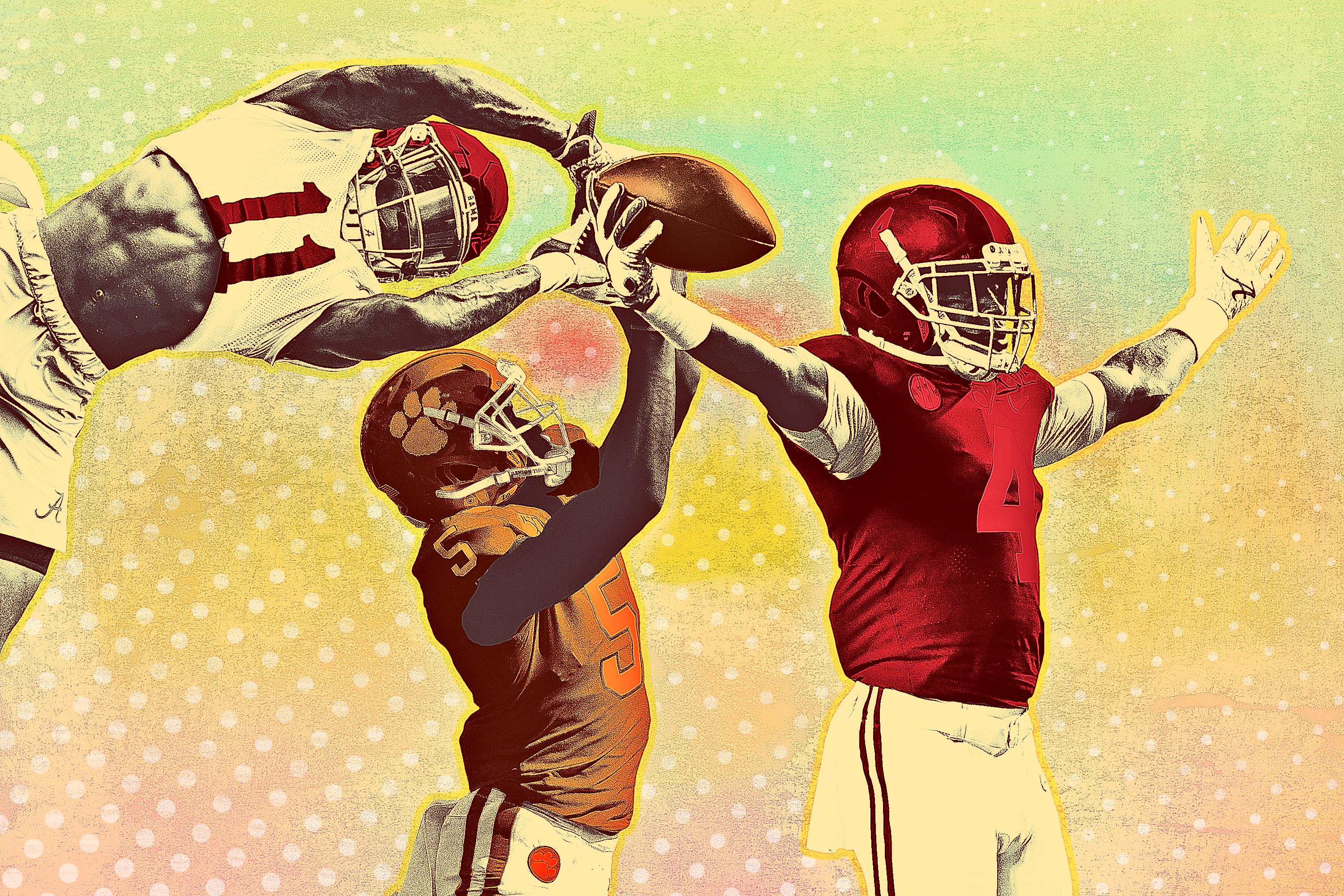
The NFL’s rookie receiver class has outplayed expectations in the early going this year, with seven first-year pass catchers―the Ravens’ Marquise Brown, Redskins’ Terry McLaurin, Seahawks’ DK Metcalf, Chiefs’ Mecole Hardman, Dolphins’ Preston Williams, 49ers’ Deebo Samuel, and Titans’ A.J. Brown―all ranked in the top 60 in receiving yards after three weeks. Though young wide receivers often take years to break into starting lineups, a shocking number of rookies have given their teams major offensive boosts this year.
But while this season’s unexpected first-year receiver breakthrough has been exciting, I’ll admit that it’s just gotten me―and probably countless other draft-obsessed fans and analysts―that much more excited for next year’s receiver class, which is expected to be even better. That group is headlined by Alabama’s Jerry Jeudy and Henry Ruggs III, Clemon’s Tee Higgins, Colorado’s Laviska Shenault Jr., and Oklahoma’s CeeDee Lamb. It’s all too common to overhype the proverbial Next Class, but that talent-packed group of receivers brings the potential to be one of the best we’ve seen this decade. With that in mind, if you aren’t already, it’s time to start getting excited about the 2020 receiver class.
This year’s receivers group was anything but top-heavy, with just three wideouts (Brown, N’Keal Harry, and Samuel) taken in the top 50 picks. Instead, its strength came from its day-two and day-three playmakers. That has been apparent in the first three weeks of the season: Marquise Brown, who was the first receiver selected at no. 25 overall, has led the way for the class (14 catches for 282 yards and two touchdowns), but he’s been bolstered by second-rounders in Samuel (11 catches, 147 yards, one touchdown), A.J. Brown (seven catches, 129 yards), Metcalf (nine catches, 217 yards, one touchdown) and Hardman (six catches, 158 yards, two touchdowns); a third-rounder in McLaurin (16 catches, 257 yards, three touchdowns); and an undrafted free agent in Williams (11 catches, 155 yards, one touchdown). Add in fifth-rounder Darius Slayton, who caught three passes for 82 yards in his first game with the Giants last Sunday and appears to have a nice connection with new starter Daniel Jones, along with sixth-rounder KeeSean Johnson (nine catches, 90 yards), who has played a regular role for the Cardinals early on, and the class has contributors coming from just about every area of the draft. Colts second-rounder Parris Campbell and Steelers third-rounder Diontae Johnson both look poised to break out over the next few weeks as well.
The 2020 receiver class looks similarly primed to feature a multitude of day-two and day-three early-impact players. But in contrast to this year’s group, it’s also heavy at the top, with a chance to produce a handful of elite―perhaps even top-10―talents this April. Jeudy, at 6-foot-1, 192 pounds, is an early favorite to hear his name called in the early first. He checked in at no. 1 overall on Mel Kiper’s big board this week and brings elite upside thanks to his sharp routes, strong hands, elite start-stop acceleration, and creativity after the catch.
The 20-year-old phenom has followed up his 68-catch, 1,315-yard, 14-touchdown performance last year with a strong start to this season, racking up 30 catches for 404 yards and six scores in just four games.
It looks like Jeudy will get a run for his money, though, from his teammate in Ruggs III (6-foot, 190 pounds), who has seen his stock rise in the first month of the season (he’s no. 7 on Kiper’s big board). The dynamic field-stretching playmaker has built on his 46-catch, 741-yard, 11-touchdown performance last year with a 16-350-4 line this season. The speedster boasts 4.2 speed (he may even threaten to break John Ross’s 2017 combine record of 4.22 seconds in the 40) and has a nose for the end zone, with 22 career touchdowns on just 75 touches. It feels almost inevitable that Ruggs III will somehow end up on the Chiefs.
Speaking of the Chiefs, Colorado’s Laviska Shenault Jr. (6-foot-2, 220 pounds) is drawing first-round hype thanks to a stylistic profile that is best described as a cross between Sammy Watkins and Cordarrelle Patterson. He’s a powerful athlete who can take the top off a defense on a post route on one play and then turn around and pick up chunks of yards via an end-around, screen, or even a direct snap on the next.
Shenault Jr. racked up 86 catches for 1,011 yards and six touchdowns in just nine games as a sophomore in 2018 and has gained 292 yards and three touchdowns on 26 touches in a little over three games this season (he left early in Colorado’s win over Arizona State last week with an undisclosed injury).
Oklahoma’s CeeDee Lamb (6-foot-2, 189 pounds) should see plenty of round-one buzz as well. The 20-year-old pass catcher was overshadowed by Marquise Brown last year but was nearly as productive, racking up 65 catches for 1,158 yards and 11 touchdowns as a sophomore. Through three games this season, he has nine catches for 229 yards (for a cool 25.4-yard average) and three touchdowns (with another rushing touchdown). He offers good size, excellent footwork, the speed to get deep, and savvy route-running.
Clemson’s Tee Higgins (6-foot-4, 215 pounds) has top-tier size, deep-ball prowess, and first-round buzz as well. The 20-year-old junior is looking to build on his 59-catch, 936-yard, 12-touchdown line as a sophomore, and has averaged 23.5 yards per reception this season, pulling in 16 catches for 376 yards and two scores in three games. He effortlessly glides past defenders and has soft hands to pull in quarterback Trevor Lawrence’s downfield bombs.
That group of potential first-rounders represents just the tip of the iceberg for this class, though. Keep an eye out for Texas’s Collin Johnson (who stands 6-foot-6, 220 pounds), South Carolina’s Bryan Edwards (6-foot-3, 215 pounds), and TCU’s Jalen Reagor (5-foot-11, 195 pounds), all of whom have also gotten some first-round hype. Minnesota’s Tyler Johnson (6-foot-2, 205 pounds), Oklahoma State’s Tylan Wallace (6-foot, 185 pounds), and Michigan’s Donovan Peoples-Jones (6-foot-2, 208 pounds) aren’t far behind, and receivers like USC’s Michael Pittman Jr. (6-foot-4, 220 pounds), Ohio State’s K.J. Hill (6-foot, 195 pounds), Texas A&M’s Kendrick Rogers (6-foot-4, 204 pounds), and Liberty’s Antonio Gandy-Golden (6-foot-4, 220 pounds), just to name a few, could all move up boards by the time April rolls around.
Together, the 2020 receiver class looks talented and deep enough to challenge the now-legendary group from the 2014 draft as the best this decade. That class, which produced Sammy Watkins, Mike Evans, Odell Beckham Jr., Brandin Cooks, Davante Adams, Jarvis Landry, and Allen Robinson, among others, hasn’t come close to finding a challenger for championship belt. (Those are seven of the 14 highest-paid receivers in average annual value in the NFL right now, by the way.)
And look, I’d understand if you want to take the hype around next year’s receiver group with a grain of salt. After all, most of the receiver draft classes of the last decade are littered with big-name busts. Take the 2012 class: Justin Blackmon (fifth overall) played just two seasons; Michael Floyd (13th) had a few decent years before multiple DUI arrests derailed his career; Kendall Wright (20th) produced just one 1,000-yard season; and A.J. Jenkins (30th), Brian Quick (33rd), and Stephen Hill (43rd) were all busts. The 2013 class was hit and miss: DeAndre Hopkins (27th) and Keenan Allen (76th) are two of the best in the game, while Robert Woods (41st) is the best … at least if you ask Troy Aikman. But Tavon Austin (eighth) was a huge bust and Cordarrelle Patterson (29th) never developed into more than a gadget player and elite return man. Justin Hunter (34th) and Aaron Dobson (59th), meanwhile, both struggled to make the jump to the NFL.
Of the 2015 class, Amari Cooper has lived up to his no. 4 overall draft billing (albeit now with a different team), and Nelson Agholor (20th), Phillip Dorsett (29th), and Devin Funchess (41th) are all still playing important roles for their teams. But Kevin White (seventh), DeVante Parker (14th), Breshad Perrmian (26th), Devin Smith (37th), and Dorial Green-Beckham (40th) have all been major disappointments. As for the 2016 draft, it did produce Will Fuller (21st overall), but was also headlined by Corey Coleman (15th), Josh Doctson (22nd), and Laquon Treadwell (23rd), with all three ending up as complete busts. At least second-rounders Michael Thomas, Sterling Shepard, and Tyler Boyd have thrived.
But there’s reason to believe that the league has started to reverse the trend of missing badly at the receiver position. The jury is still out on the 2017 and 2018 drafts, of course, but with Mike Williams, Curtis Samuel, Juju Smith-Schuster, Cooper Kupp, Chris Godwin, Kenny Golladay, D.J. Moore, Calvin Ridley, Courtland Sutton, Christian Kirk, DJ Chark, and Michael Gallup all producing big plays for their respective teams this year, it’s safe to say that those two groups are headed in the right direction. Add in what already looks like a dynamic 2019 draft class, and it becomes easy to get excited for this 2020 group.
The league has changed; a new generation of star quarterbacks has begun to emerge, and perhaps most importantly, coaches seem to be learning how to deploy inexperienced yet explosive playmakers within their offenses. The lines have slowly begun to blur between the college and pro games; teams have increasingly adopted more wide-open looks, shotgun formations, and simpler play-calling language while working to scheme up ways to get playmakers the ball in space. Instead of forcing rookies to learn the route intricacies and precision timing required to run complex pro-style drop-back passing schemes, coaches are showing the willingness to scheme up ways to get their best athletes involved from day one. Or, in some cases, they’re simply running the same schemes these receivers played in college.
Take a look at McLaurin’s Week 1 route chart, which illustrates how the Redskins looked to exploit his most basic skill: speed. The rookie ran a combination of crossing routes, posts deep down the middle, and a fade route toward the sideline. Metcalf’s Week 2 route chart (which looks nearly identical to his other two games this year) shows that the Seahawks are asking the rookie to do basically the exact same thing he did at Ole Miss; the Chiefs haven’t asked Hardman to do too much, other than blow by defenders on sweeps or go-routes downfield, and Samuel’s been a yards-after-the-catch creator for the 49ers.
That’s why, whether I’m studying Jeudy’s after-the-catch jump-cut prowess, Ruggs’s easy speed downfield, or Higgins’s ability to attack the ball in the air, it’s not hard to visualize the top playmakers from the projected 2020 receiver draft class making the jump into the pro game. It’s already easy to see, too, that this receiver class (assuming the top underclassmen continue on their trajectory and declare for the draft) is far more talented than any group in recent memory. The sky is the limit for the class of 2020.

